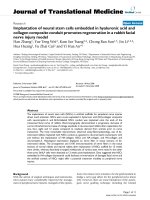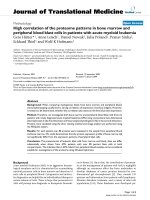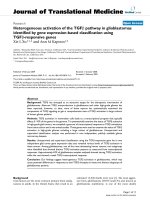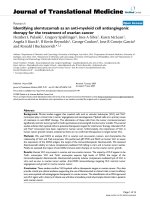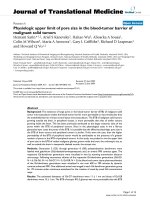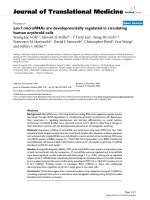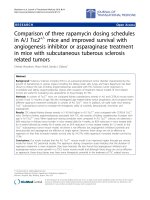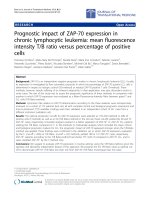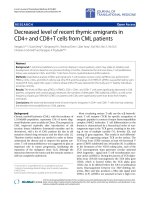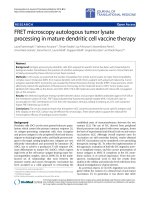Báo cáo hóa học: " Circle drawing as evaluative movement task in stroke rehabilitation: an explorative study" potx
Bạn đang xem bản rút gọn của tài liệu. Xem và tải ngay bản đầy đủ của tài liệu tại đây (1.06 MB, 11 trang )
JNER
JOURNAL OF NEUROENGINEERING
AND REHABILITATION
Circle drawing as evaluative movement task in
stroke rehabilitation: an explorative study
Krabben et al.
Krabben et al. Journal of NeuroEngineering and Rehabilitation 2011, 8:15
(24 March 2011)
RESEARCH Open Access
Circle drawing as evaluative movement task in
stroke rehabilitation: an explorative study
Thijs Krabben
1*
, Birgit I Molier
1
, Annemieke Houwink
2
, Johan S Rietman
1,3
, Jaap H Buurke
1,4
and
Gerdienke B Prange
1
Abstract
Background: The majority of stroke survivors have to cope with deficits in arm function, which is often measured
with subjective clinical scales. The objective of this study is to examine whether circle drawing metrics are suitable
objective outcome measures for measuring upper extremity function of stroke survivors.
Methods: Stroke survivors (n = 16) and healthy subjects (n = 20) drew circles, as big and as round as possible,
above a table top. Joint angles and positions were measured. Circle area and roundness were calculated, and
synergistic movement patterns were identified based on simultaneous changes of the elevation angle and elbow
angle.
Results: Stroke survivors had statistically significant lower values for circle area, roundness and joint excursions,
compared to healthy subjects. Stroke survivors moved significantly more within synergistic movement patterns,
compared to healthy subjects. Strong correlations between the proximal upper extremity part of the Fugl-Meyer
scale and circle area, roundness, joint excursions and the use of synergistic movement patterns were found.
Conclusions: The present study showed statistically significant differences in circle area, roundness and the use of
synergistic movement patterns between healthy subjects and stroke survivors. These circle metrics are strongly
correlated to stroke severity, as indicated by the proximal upper extremity part of the FM score.
In clinical practice, circle area and roundness can give useful objective information regarding arm function of stroke
survivors. In a research setting, outcome measures addressing the occurrence of synergistic movement patterns
can help to increase understanding of mechanisms involved in restoration of post stroke upper extremity function.
Background
Introduction
Stroke is described as “an extremely complex breakdown
of many neural systems, leading to motor as well as per-
ceptual, cognitive and behavioral problems” [1]. Motor
problems of the upper extremity following stroke
include muscle weakness, spasms, disturbed muscle tim-
ing and a reduced ability to selectively activate muscles.
Many stroke survivors move in abnormal synergistic
movement patterns that already have been described
decades ago [2,3]. More recent studies of Beer [4-6] and
Dewald [7-9] showed strong coupling of the shoulder
and elbow joint in stroke survivo rs in both isometric
and dynamic conditions.
Six months after stroke, motor problems are still pre-
sent in the majority of stroke survivors [10], limiting
their ability to perform activities of daily living (ADL).
Post stroke rehabilitation training aims to regain (partly)
lost functions by stimulation of restoration or promoting
compensational strategies, in order to increase the level
of independence. During rehabilitation training move-
ments are practiced preferably with high intensity, in a
task-oriented way, with an active contribution of the
stroke survivor in a motivating environment where feed-
back on performance and error is provided [11].
Robotics
A promising way to integrate these key elements of
motor relearning into post stroke rehabilitation training
is the use of robotic systems. Systematic reviews indi-
cated a positive effect on arm function after robot-aided
arm rehabilitation training [12,13]. Six months after
* Correspondence:
1
Roessingh Research and Development, Roessinghsbleekweg 33B, Enschede,
the Netherlands
Full list of author information is available at the end of the article
Krabben et al. Journal of NeuroEngineering and Rehabilitation 2011, 8:15
/>JNER
JOURNAL OF NEUROENGINEERING
AND REHABILITATION
© 2011 Krabben et al; licensee BioMed Central Ltd. This is an Open Access article distributed under the terms of the Creative Commons
Attribu tion License ( which permits unrestricted use, distribut ion, and reproduction in
any medium, provided the original work is properl y cited.
training, the effect of robotic traini ng is at least as large
as the effect of conventional training [14].
Besides training, robotic rehabilitation systems can be
valuable tools for evaluation purposes. Q uantities of
body functi ons concerning movement performance [15]
can be measured objectively with integrated sensors of
many robot syst ems. Objective measur ement of motor
performance in s troke survivors is important to s tudy
the effectiveness of different re habili tat ion training pro -
grammes, in order to identify the most beneficial
approaches. The use of objective outcome measures,
strongly related to affected body functions and struc-
tures, can help to unders tand the mechanism s that are
involved in restoration of arm function in order to max-
imize the effect of future approaches. Despite the
increasing use of robotic systems in clinical and research
settings, it is still questioned which of the wide variety
of available robotic outcome measures are relevant to
study arm movement ability following stroke.
Outcome measures
Currently, therapy effectiven ess is generally assessed
with clinical scales. However, some clinical scales show
a lack of reproducibility, in addition to subjectivity when
scoring the test. One way to obtain objective and speci-
fic information concerning arm function at the body
function level is to measure kinematics o f the arm, as
can be done by many upper extremity robotic systems.
Recently, relations between active range of motion
(aROM) and clinical scales as the Fugl-Meyer (FM)
scale, the Chedoke McMaster Stroke Assessment score
and the Stroke Impact Scale w ere studied [16]. Strong
correlations were found between the FM scale and an
aROM task, performed in the horizontal plane with the
upper arm elevated to 90 degrees. A movement task
highly similar to the aROM task used in [16] is circle
drawing.
Circle task
Successful circle drawing requires coordination of both
the shoulder a nd elbow joint which makes it a poten-
tially useful movement task to study multi-joint coordi-
nation. Dipietro et al. [17] showed that the effect of a
robotic training intervention could be quantified by sev-
eral outcome measur es obtained during circular hand
movements that were performed at table height. Because
of the multi-joint nature of the movement task, circle
drawing is a suitable task to study body functions [18]
such as ranges of joint motion and coupling between
the shoulder and elbow joint. In addition, circle area
gives a quantitative description of the size of the region
where someone can place his/her hand to grasp and
manipulate objects. Such an outcome measure at the
activity level gives functional information, in this case
regarding the work space of the arm.
Objective
The aim of this study is to examine whether circle
drawing metrics are suitable outcome measures for
objective assessment of upper extremity function of
stroke survivors. A new method to objectively quantify
the occurrence of synergistic movement patterns i s
introduced. Outcome measures will be compared
between healthy subjects and stroke survivors to study
the discriminative power between these groups. Within
stroke survivors, correlations between outcome mea-
sures including the FM are ad dressed to s tudy mutual
dependencies.
Methods
Subjects
Chronic stroke survivors were recruited at rehabilitation
centre ‘Het Roessingh’ in Enschede, the Netherlands.
Inclusion criteria were a right-sided hemiparesis because
of a single unilateral strok e in the left he misphere and
the ability to move the shoulder and elbow joints partly
against gravity. Healthy elderly (45-80 years) were
recruited at the research department and from the local
community. Exclusion criteria for both groups were
shoulder pain and the inability to understand the
instructions given. All subjects provided written
informed consent. The study was approved by the local
medical ethics committee.
Procedures
During a measurement session, subjects were seated on
a chair with the arm fastened to an instrumented exos-
keleton called Dampace [19]. This exoskeleton was only
used for measurements and did not support the arm.
Stroke subjects were asked to draw 5 and he althy sub-
jects were asked to draw 15 consec utive circles during a
continuous movement in both the clockwise (CW) and
counter clockwise (CCW) direction. Circle drawing
started with the hand close to the body, just above a
tabletop of 75 cm height. The upper arm was aligned
with the trunk and the angle between the upper arm
and forearm was approximately 90 degrees. Templates
of circles o f different radii were shown on the tabletop
to motivate subjects to draw the circles as big and as
round as possible. To minimize the effect of c ompensa-
tory trunk movements on the shape and size of the cir-
cles, the trunk of each subject was strapped with a four
point safety belt. Movements were performed at a self
selected speed, without touching the table . The order of
direction of the circle drawing task (CW or CCW) was
randomized across subjects.
Krabben et al. Journal of NeuroEngineering and Rehabilitation 2011, 8:15
/>Page 3 of 11
Measurements
Kinematic data were recorded with sensors integrated in
the robotic exoskeleton [19]. Potentiometers on three
rotational axes allowed measurements of upper arm ele-
vation, transversal rotation, and axial rotation. A rota-
tional optical encoder was used to measure elbow
flexion and extension. Shoulder translations were mea-
sured with linear optical encoders. Signals from the
potentiometers were converted from analog to digital
(AD) by a 16 bits AD-converter (PCI 6034, National
Instruments, Austin, Texas). The optical quadrature
encoders were sampled by a 32 bits counter card
(PCI6602, National Instruments, Austin, Texas). Digital
values were sampled with a rate o f 1 kHz, online low-
pass filtered with a first order Butterworth filter with a
cut-off frequency of 40 Hz and stored o n a computer
with a sample frequency of at least 20 Hz.
Arm segment lengths were measured to translate mea-
sured joint angles into joint positions. Upper arm length
was measured between the acromion and the lateral epi-
condyle of the humerus. The length of the forearm was
defined as the distance between the lateral epicondyle of
the humerus and the third metacarpophalangeal joint.
Thoracohumeral joint angles were measured according
to the recommendations of the International Society of
Biomechanics [20]. The orientation of the upper arm
was represented by three angles, see Figu re 1. The plane
of elevation (EP) was defined as the angle between the
humerus and a virtual line through the shoulders. The
elevation angle (EA) represented the angle between the
thorax and the humerus, in the plane of elevation. Axial
rotation (AR) was expressed as the rotation around a
virtual line from the glenohumeral joint to the elbow
joint. The elbow flexion angle (EF) was defined as the
angle between the forearm and the humerus. Joint
excursions were calculated as the range between mini-
mal and maximal joint angles during circle drawing.
Level o f impairment of the hemiparetic arm of stroke
survivors at the time of the experiment was assessed
with the upper extremity part (max 66 points) of the
FM scale [21]. Because the focus of the present study is
on proximal arm function, a subset of the upper extre-
mity part of the FM scale consisting of items A
II
,A
III
and A
IV
(max 30 points) was addressed separately
(FMp).
Data analysis
All measured signals were off-line filtered with a first
order zero phase shift low-pass Butterworth filter with a
cut-off frequency of 5 Hz. Joint positions were calcu-
lated by means of the measured shoulder displacement
and successive multiplication of the mea sured joint
angles and the transformation matrices defined for each
arm segment. Joint positions were expressed relative to
the shoulder position to minimize the contribution of
trunk movements to the size and shape of the drawn
circles.
Individual circles wer e extracted from the data
between two minima of the Euclidean distance in the
horizontal plane be tween the hand path and the
shoulder position, which was represented in the origin.
After visual inspection of the data for correctness and
completeness, the three largest circles in both the CW
and CCW direction were averaged and used for further
analysis.
Circle drawing metrics
The area of the enclosed hand path reflects the active
range of motion of both healthy subjects and stroke sur-
vivors, see Figure 2 for typ ical examples. Normalized cir-
cle area (normA) is expressed as ratio betw een the area
of the enclosed hand path and the maximal circle area
that is biomechanically possible to compensate for the
effect of a rm length on maximal circle area, see Figure 3.
Circle area is considered maximal when the diameter of
the circle equals the arm length of the subject.
Circle morphology was evaluated by calculation of the
roundness as described in Oliveira et al. [22] and
Figure 1 Visual representation of the joint angles of the upper arm. Arrows indicate positive rotations. EP = Elevation Plane, EA =
Elevation Angle, AR = Axial rotation, EF = Elbow Flexion.
Krabben et al. Journal of NeuroEngineering and Rehabilitation 2011, 8:15
/>Page 4 of 11
previously used to evaluate training induced changes in
synergistic movement patterns during circle drawing of
stroke survivors [ 23,17]. In this method, roundness is
calculated as the quotient of the minor and major axes
(see Figure 2) of the ellipse which is fitted onto the
hand path by means of a principal component an alysis.
The calculated roundness lies between 0 and 1 and a
perfectly round circle yields a roundness of 1.
To explicitly study the potential impact of synergistic
movement patterns on circle drawing, movements within
and out of the flexion and extension synergies were identi-
fied based on simultaneous changes in shoulder abduc-
tion/adduction (EA) and elbow flexion/extension (EF)
angles. When the angular velocity of both shoulder abduc-
tion and elbow flexion exceeded 2% of their maximal
values, movement was regarded as movement within the
flexion synergy (InFlex). Movem ent within the ex tension
synergy (InExt) was characterized by concurrent shoulder
adduction and elbow extension, both exceeding the
threshold value of 2% of the maximal angular velocity. In a
similar way movement out of the flexion syne rgy (Out-
Flex) was characterized by simultaneous shoulder abduc-
tion and elbow ext ension, while movement out of the
extension synergy (OutExt) comprised shoulder adduction
and elbow flexion. If the angular velocity of one joint was
below the threshold this was regarded as a single-joint
movement (SJMov). InFlex and InE xt represented move-
ment within a synergistic pattern (InSyn). The ability to
move out of a synergistic pattern (OutSyn) was calculated
as the sum of OutFlex and OutExt.
Statistical analysis
For statistical analysis, all data were tested for normality
with the Kolmogorov-Smirno v test. Initial analysis
−20−100102030
25
30
35
40
45
50
55
60
x (cm)
z (cm)
Hand path
Fitted ellipse
0 1 2 3 4 5
−50
0
50
t (s)
v (cm/s)
Vx
Vz
Vt
−20−100102030
25
30
35
40
45
50
55
60
x (cm)
z (cm)
Hand path
Fitted ellipse
0 1 2 3 4 5
−50
0
50
t (s)
v (cm/s)
Vx
Vz
Vt
−20−100102030
25
30
35
40
45
50
55
60
x (cm)
z (cm)
R
m
a
j
o
r
R
m
i
n
o
r
Hand path
Fitted ellipse
0 1 2 3 4 5
−50
0
50
t (s)
v (cm/s)
Vx
Vz
Vt
Figure 2 Typical examples of hand paths (top) and corresponding speed profiles (bottom). Data from stroke survivors with FM = 9 (left),
FM = 45 (middle) and a healthy subject (right). FM = Fugl-Meyer, Vx = speed in x-direction, Vz = speed in z-direction, Vt = tangential speed,
Rmajor = major axis fitted ellipse, Rminor = minor axis fitted ellipse.
Figure 3 Graphical representation of the calculation of the
normalized work area (normA). The area (A
1
) enclosed by the
hand path is divided by the area (A
2
) of a circle with a diameter
equal to the length of the arm, measured between the acromion
and the third metacarpophalangeal joint.
Krabben et al. Journal of NeuroEngineering and Rehabilitation 2011, 8:15
/>Page 5 of 11
revealed a small but statistically significant difference in
age between both groups, see Table 1. For that reason,
all outcome measures were tested for their ability to dis-
criminate between healthy subjects and stroke survivors
by means of analysis of covariance (ANCOVA) with
fixed factor ‘group’ and covariate ‘age’.Within-subject
relations between outcome measures were identified and
tested with Pear son’ s correlation coefficients. Correla-
tions were considered weak when r <0.30,moderate
when 0.30 ≤ r ≤ 50 and strong when r > 0.50 [24]. The
significance level for all statistical tests was defined as
a = 0.05.
Results
Subjects
A total of 36 subjects, 20 healthy subjects and 16 stroke
survivors, participated in this study. Characteristics of
the subjects are summarized in Table 1. All stroke survi-
vors had right-sided hemiparesis, which affected the
dominant arm in all but one subject. All healthy subjects
performed movements with the dominant arm. Stroke
survivors were on average 4.8 years older than healthy
subjects, p = 0.032. The effect of age on all outcome
measur es did not differ significantly between stroke sur-
vivors and healthy elderly, as indicated by non-signifi-
cant interaction terms (group*age), p > 0.12.
Circle metrics
Outcomemeasureswerenormallydistributedinboth
healthy subjects (p ≥ 0.337) and stroke survivors (p ≥
0.365) as indica ted by the Kolmogorov-Smirnov test for
normality. Group mean normA in healthy subjects was
34.6 ± 6.7%, which is significantly (p < 0.001) larger
than the mean normA in stroke survivors, which was
12.8 ± 12.3% (see Figure 2 for typical examples). On
average, roundness was significantly higher (p < 0.001)
in the healthy group (0.66 ± 0.07) compared to the
stroke survivor group (0.39 ± 0.17). Healthy subjects
had significantly (p < 0.001) higher self selected move-
ment speeds compared to stroke survivors (respectively
45.5 ± 8.6 and 16.2 ± 8.0 cm/s) and significantly (p <
0.001) shorter movement times to draw one circle
(respectively 3.2 ± 0.9 and 7.8 ± 5.1 s).
Joint excursions
All measured joint excursions during circle drawing
were significantly smaller (p < 0.001) in stroke survivors
compared to the healthy subjects, see Figure 4. Healthy
subjects varied EP on average 89.4 ± 9.5 degrees, against
58.7 ± 25.3 degrees for stroke survivors. T he mean
excursion of EA in healthy subjects was 16.1 ± 3.8
degrees, and 8.1 ± 5.9 degrees in stroke survivors. Mean
variations in AR for healthy subjects and stroke survi-
vors were respectively 42.9 ± 9.8 and 25.6 ± 14.3
degrees. EF was on average 91.9 ± 6.9 degrees in healthy
subjects and 34.9 ± 25.5 degrees in stroke survivors.
Synergistic movement patterns
The occurrence of synergistic movement patterns during
circle drawing in both healthy subjects and stroke survi-
vors are graphically displayed in Figure 5. Healthy sub-
jects moved on average 11.5 ± 4.6% of the movement
time within synergistic patterns, which was significantly
(p = 0.005) less than stroke survivors, who moved dur-
ing 22.2 ± 15.6% of the movem ent time within synergis-
tic patterns. In the healthy group, OutSyn was on
average 82.2 ± 4.7 percent which was significantly (p <
0.001) higher than in the stroke survivor group with
mean OutSyn of 66.7 ± 16.6%. Finally, SJMov was on
average 6.3 ± 0.9% in healthy subjects, and 11.1 ± 6 .6%
in stroke survivors, which is a statistically significant dif-
ference, p = 0.011.
Table 1 Subject demographic and clinical characteristics
Healthy Stroke
n2016
Age (yrs) 53.9 ± 5.3 58.7 ± 7.4
Gender 10 M/10 F 8 M/8 F
Dominance 20 R/0 L 15 R/1 L
Time post stroke (yrs) - 3.3 ± 2.6
Fugl-Meyer (max 66) - 33.4 ± 17.6 (7 - 60)
Fugl-Meyer proximal (max 30) - 15.8 ± 8.5 (1 - 29)
Abbreviations:
M = male, F = female, R = right side, L = left side.
EP EA AR EF
0
10
20
30
40
50
60
70
80
90
100
Degrees
Healthy
Stroke
Figure 4 Group mean joint excursions during circle drawing of
healthy subjects and stroke survivors. Error bars indicate one
standard deviation. EP = Elevation Plane, EA = Elevation Angle, AR =
Axial Rotation, EF = Elbow Flexion.
Krabben et al. Journal of NeuroEngineering and Rehabilitation 2011, 8:15
/>Page 6 of 11
Relations between outcome measures
Pearson’s correlation coefficients between the used out-
come measures of stroke survivors are displayed in
Table 2. The outcome measures used to describe the
size and shape of the drawn circles a re strongly related
to the proximal part of the upper extremity portion of
theFMscale(r =0.86andr = 0.79, respectively).
Strong positive correlations can also be seen between
the joint excursions and the size and shape of the circle
(r ≥ 0.76).
Movement within synergistic patterns is negatively cor-
related with FMp (r = -0.76), FM (r = -0.72), and the
size and shape of the circles, r < -0.56, see Table 2 and
Figure 6. InSyn is al so negatively correlated with joint
excursions (r < -0.48), indicating that subjects gen erally
have smaller joint excursions when movement takes
place within synergistic pa tterns. The ab ility to move out
of synergistic movement patterns as indicated by OutSyn
is positively correlated with the FMp (r =0.84),FM(r =
0.84) and the size and shape of the circles (r > 0.62).
Healthy Stroke
0
10
20
30
40
50
60
70
80
90
100
InSyn
% movement time
Healthy Stroke
OutSyn
Healthy Stroke
SJMov
Figure 5 Occurrence of synergistic movement patterns during circle drawing. Boxplots of movement within (InSyn) or out of (OutSyn)
synergistic movement patterns and single-joint movements (SJMov) of healthy subjects and stroke survivors.
Table 2 Pearson’s correlation coefficients between outcome measures
FM FMp normA rness InSyn OutSyn SJMov EP EA AR EF
FM 1 0.97 0.79 0.75 -0.72 0.84 -0.41 0.63 0.58 0.63 0.83
FMp 0.97 1 0.86 0.79 -0.76 0.84 -0.33 0.77 0.68 0.72 0.90
normA 0.79 0.86 1 0.78 -0.56 0.62 -0.24 0.87 0.90 0.84 0.95
rness 0.75 0.79 0.78 1 -0.65 0.78 -0.44 0.76 0.79 0.87 0.91
InSyn -0.72 -0.76 -0.56 -0.65 1 -0.92 -0.06 -0.61 -0.48 -0.49 -0.64
OutSyn 0.84 0.84 0.62 0.78 -0.92 1 -0.35 0.57 0.52 0.59 0.73
SJMov -0.41 -0.33 -0.24 -0.44 -0.06 -0.35 1 0.01 -0.18 -0.33 -0.31
EP 0.63 0.77 0.87 0.76 -0.61 0.57 0.01 1 0.81 0.90 0.86
EA 0.58 0.68 0.90 0.79 -0.48 0.52 -0.18 0.81 1 0.85 0.87
AR 0.63 0.72 0.84 0.87 -0.49 0.59 -0.33 0.90 0.85 1 0.87
EF 0.83 0.90 0.95 0.91 -0.64 0.73 -0.31 0.86 0.87 0.87 1
Abbreviations:
FM = Fugl-Meyer, FMp = proximal part of upper extremity part of Fugl-Meyer, normA = normalized circle area, rness = roundness , InSyn = movement within
synergistic pattern, OutSyn = movement out of synergistic pattern, SJMov = Single-Joint Movement, EP = Elevation Plane, EA = Elevation Angle, AR = Axial
Rotation, EF = Elbow Flexion.
Krabben et al. Journal of NeuroEngineering and Rehabilitation 2011, 8:15
/>Page 7 of 11
Movement out of synergistic patterns is also positively
correlated with joint excursions (r > 0.52).
Discussion
In this study a standardized motor task and corresponding
metrics were examined for discriminative power between
healthy subjects and stroke su rvivors. Significant differ-
ences in normalized circle area, circle roundness, and the
occurrence of synergistic movement patterns between
healthy a nd stroke survivors were found, indicating the
ability of these outcome measures to discriminate between
these two groups. Also strong within-subject relatio ns
were found between several outcome measures in a sam-
ple of mildly to severely affected chronic stroke survivors.
Work area
Reduced aROM during various movement tasks is com-
monly observed in stroke survivors, for example during
planar pointing movements [25]. The present study indi-
cates that joint excursions of the hemiparetic shoulder
and elbow are diminished, resulting in a reduced work
area of the hand. This finding is supported by studies of
Sukal and Ellis [16,26] who showed a reduced work area
of the paretic arm compared to the unaffected arm, dur-
ing an aROM task with the upper arm elevated to 90
degr ees (comparable to EA = -90 degrees in the present
study).
Roundness
Roundness of circles drawn by stroke survivors was pre-
viously studied by Dipietro and colleagues [23,17]. The
method of determining roundness of a circle [22] was
equal in the present study and the studies by Dipietro
et al. During baseline measurements Dipietro et al. [17]
found a mean roundness o f 0.51 in a sample of 117
chronic stroke survivors with a mean FM score of 20.5.
0 5 10 15 20 25 30
0
10
20
30
40
50
60
70
80
90
100
FMp
% movement time
InSyn
OutSyn
Figure 6 Relation between the proximal part of the upper extremity part of the FM scale (FMp) and the occurrence of synergistic
movement patterns. InSyn = movement within synergistic pattern, OutSyn = movement out of synergistic pattern.
Krabben et al. Journal of NeuroEngineering and Rehabilitation 2011, 8:15
/>Page 8 of 11
Mean roundness of the circles drawn by the chronic
stroke survivors (mean FM 33.4 points) in the present
study was 0.39, indicating that circles were more elliptical
(i.e. less round). This was unexpected since a positive
correlation coefficient ( r = 0.76) between the FM score
and roundness was found. A possible explanation for this
discrepancy was already hypothesized in Dipietro et al.,
they measured subjects while the arm was supported
against gravity. Application of gravity compensation
reduces the activation le vel of shoulder abductors needed
to hold the arm against grav ity, and as a r esult the
amount of coupled involuntary elbow flexion is
decreased, leading to an increased ability to extend the
elbow [6,27]. In the case of circle drawing, increase in
aROM due to gravity compensation can lead to smaller
differences in lengths of the major and minor axes of the
fitted ellipse, resulting in higher values for roundness.
Work area and FM
In the present study, a strong correlation between
aROM, as represented by the normalized circle area,
and the FM scale was found. Similar results were found
in a study performed b y Ellis et al [16]. In that study,
aROM of stroke survivors during different limb loadings
was measured. Movement was performed in the hori-
zontal plane, with the upper arm elevat ed to 90 degrees.
Correlation between aROM and FM varied with limb
loading, and was 0.69 in the unsupported condition. In
the present study, correlation between FM and normal-
ized circle area was higher with a correlation coefficient
of 0.79. The difference in correlation coefficients can be
caused by differences in the performed movement task.
During the study by Ellis et al. subjects were asked to
make a movement as big as possible without instruc-
tions concerning the shape of the movement. Partici-
pants of the present study were asked to make circular
movementsasbigandasroundaspossible.Alsosome
differences in applied normalization procedures to mini-
mize the effect of arm length on work area may contri-
bute to differences in correlation between FM and
aROM. Nevertheless, both studies showed strong rela-
tions between FM and aROM, indicating that circle area
is a suitable outcome measure to objectively study activ-
ities of the upper extremity following stroke.
Roundness and FM
Compared to the present study, Dipietro et al. [17]
found similar, but less pronounced correlations between
roundness and the FM scale (r =0.55againstr =0.75)
and between roundness and the proximal upper extre-
mity part of the FM scale (r =0.61againstr = 0.79)
during baseline and evaluation measurements. Because
subjects in the study of Dipietro et al. drew circles in a
gravity compensated environment, joint coupling during
circle drawing is likely to be less prono unced compared
to the unsupported arm movements that were made
during the FM assessment, resulting in a less strong cor-
relation between the FM score and circle roundness.
Joint coupling and FM
Again, concerning the correlation between the FM and
joint coupling, a comparison between Dipietro et al. [17]
and the present study reveals a stronger correlation in
the latter one, which is likely related to the use of grav-
ity compensation in Dipietro et al.
Also, Dipietro et al. studied joint coupling by compari-
son of shoulder horizontal ab-/adduction (i.e. plane of
elevation in the present study) a nd elbow flexion/exte n-
sion angles whereas in the p resent study simultaneous
changes in elevation angle and elbow angle represented
joint coupling. A lower correlat ion between the proximal
part of the FM scale and joint coupling as calculated by
Dipietro et al. could also indica te that coupling between
plane o f elevation and elbow angle is less strong than
coupling between elevation angle and elbow angle. This
is supported by a smaller amount of se condary torque of
elbow flexion measured during an isometric maximal
voluntary c ontraction (MVC) of shoulder flexion (i.e.
shoulder horizontal adduction) compared to an MVC of
shoulder abduction [28]. Despite small differences in
motor task, methods and analyses, both studies indicate
that circle drawing is a suitable movement task to study
coupling between two joints.
Multi-joint movement
Compared to a rather strong focus on single-joint move-
ments of the FM assessment, outcome measures con-
cerning multi-joint movements are more suitable to
study motor control during movements that resemble
ADL tasks. Circle drawing is a multi-joint movement
task that requires selective and coordinated movement
of both the shoulder and elbow joint. At the activity
level, normalized circle area gives a quantitative descrip-
tionofthesizeoftheareawherethestrokesurvivor
can place his hand to grasp and manipulate objects. In
addition, the measured joint excursions, the calculated
roundness, and the occurrence of synergistic moveme nt
patterns quantify arm movement at the body function
level. Drawing tasks are often used to study motor con-
trol of the arm during multi-joint movements, for exam-
ple to study control of interaction torques between the
shoulder and elbow joints [29,30].
As demonstrated in the present study and several
other studies, circle size and roundness are strongly
related to the widely used FM scale. This suggests that
measurement of circle size and sha pe can give similar
information about the level of impairment of stroke sur-
vivors. However, circle metrics are measured objectively
Krabben et al. Journal of NeuroEngineering and Rehabilitation 2011, 8:15
/>Page 9 of 11
and are insusceptible to subjective judgment by the
examiner.
Objective outcome measures
Quantitative outcome measures strongly related to
pathological impairments can help to create a better
understanding of neurological changes induced by post
stroke rehabilitation therapy. Knowledge of size and
shape of circul ar mo vements after strok e is extended in
the present study by measurement of circle metrics in
healthy subjects. The ability to compare changes of cir-
cle metrics induced by post stroke interventions with
values obtained from a healthy population can provide
insight in whether neural recovery takes place or
whether stroke survivors use compensatory strategies.
Thedegreetowhichbothprocessesoccurmayinflu-
ence future post stroke rehabilitation programmes [31].
A better understanding of mechanisms involved in
post stroke rehabilitation is needed to maximize the
effect of future approaches to improve upper extremity
functionality. The use of standardized quantitative out-
come measures allows a uniform comparison of differ-
ent interventions to study their efficacy and identify
which interventions are the most beneficial for stroke
survivors.
Clinical implications
Measurement of the use of synergistic patterns as
described in this paper requires an advanced measure-
ment system that is capable of measuring joint angles.
These outcome measures can be useful to study under-
lying mechanisms o f restoration of a rm function after
stroke in a research setting. Circle size and roundness
can be measured not only with advanced measurement
systems, but with any measurement device that is cap-
able of measuring hand position. Besides advanced
robotic systems, one can think of simple and affordable
hand tracking devices, for instance based on a camera.
Such equipment is suitable to deploy in clini cal practice
which allows simple but objective measurement of
meaningful measures of arm function.
Conclusions
The aim of this study was to examine whether circle
drawing metrics are suitable outcome measures for
stroke rehabilitation. The present study indicates that it
is possible to make a distinction in circle area, roun d-
ness and the use of synergistic movement patterns
between healthy subjects and stroke survivors with a
wide range of stroke severity. These circle metrics are
also strongly correlated to stroke se verity, as indic ated
by the proximal upper extremity part of the FM score.
Outcome measures such as circle area and roundness
can be a valuable addition to currently used outcome
measures, because they can be measured objectively
with any measurement device that is capable of measur-
ing hand position. Such simple and affordable equip-
ment is suitable to be deployed in clinical settings.
Identification of abnormal synergistic movement pat-
terns requires more advanced equipment that is capable
of measuring joint angles of the shoulder and elbow.
Research into changes in the use of abnormal movement
patterns is useful for a better understanding of mechan-
isms that are involved in restoration of post stroke arm
function. Data obtained from healthy elderly can help to
interpret changes in circle drawing metrics of stroke
survivors, for instance to study effectiveness of post
stroke intervent ions aiming at restoration of arm
function.
Acknowledgements
This research was supported by grant I-01-02=033 from Interreg IV A, the
Netherlands and Germany, grant 1-15160 from PID Oost-Nederland, the
Netherlands and grant TSGE2050 from SenterNovem, the Netherlands.
Author details
1
Roessingh Research and Development, Roessinghsbleekweg 33B, Enschede,
the Netherlands.
2
Department of Rehabilitation, Nijmegen Centre for
Evidence Based Practice, Radboud University Nijmegen Medical Centre,
Reinier Postlaan 4, Nijmegen, the Netherlands.
3
Faculty of Electrical
Engineering, Mathematics and Informatics, University of Twente,
Drienerlolaan 5, Enschede, the Netherlands.
4
Rehabilitation Centre ‘het
Roessingh’, Roessinghsbleekweg 33, Enschede, the Netherlands.
Authors’ contributions
TK performed the design of the study, acquisition and analysis of data and
drafting of the manuscript. BIM made substantial contributions to acquisition
of the data and drafting of the manuscript. AH, JSR and JHB were involved
in interpretation of results and critical revision of the manuscript for
important intellectual content. JHB was also involved in conception and
design of the study. GBP was involved in design of the study, acquisition
and interpretation of data, drafting of the manuscript and critical revision of
the manuscript for important intellectual content. All authors have read and
approved the final manuscript.
Competing interests
The authors declare that they have no competing interests.
Received: 28 July 2010 Accepted: 24 March 2011
Published: 24 March 2011
References
1. Hochstenbach J, Mulder T: Neuropsychology and the relearning of motor
skills following stroke. Int J Rehabil Res 1999, 22:11-19.
2. Twitchell TE: The restoration of motor function following hemiplegia in
man. Brain 1951, 74(4):443-480.
3. Brunnstrom S: Movement therapy in hemiplegia, a neurophysiological
approach New York: Harper & Row Publishers Inc; 1970.
4. Beer RF, Ellis MD, Holubar BG, Dewald JPA: Impact of gravity loading on
post-stroke reaching and its relationship to weakness. Muscle Nerve 2007,
36(2):242-250.
5. Beer RF, Given JD, Dewald JP: Task-dependent weakness at the elbow in
patients with hemiparesis. Arch Phys Med Rehabil 1999, 80(7):766-772.
6. Beer RF, Dewald JPA, Dawson ML, Rymer WZ: Target-dependent
differences between free and constrained arm movements in chronic
hemiparesis. Exp Brain Res 2004, 156(4):458-470.
7. Dewald JP, Beer RF, Given JD, McGuire JR, Rymer WZ: Reorganization of
flexion reflexes in the upper extremity of hemiparetic subjects. Muscle
Nerve 1999, 22(9):1209-1221.
Krabben et al. Journal of NeuroEngineering and Rehabilitation 2011, 8:15
/>Page 10 of 11
8. Dewald JP, Sheshadri V, Dawson ML, Beer RF: Upper-limb discoordination
in hemiparetic stroke: implications for neurorehabilitation. Top Stroke
Rehabil 2001, 8:1-12.
9. Dewald JP, Pope PS, Given JD, Buchanan TS, Rymer WZ: Abnormal muscle
coactivation patterns during isometric torque generation at the elbow
and shoulder in hemiparetic subjects. Brain 1995, 118(Pt 2):495-510.
10. Kwakkel G, Kollen BJ, van der Grond J, Prevo AJH: Probability of regaining
dexterity in the flaccid upper limb: impact of severity of paresis and
time since onset in acute stroke. Stroke 2003, 34(9):2181-2186.
11. Timmermans AAA, Seelen HAM, Willmann RD, Kingma H: Technology-
assisted training of arm-hand skills in stroke: concepts on reacquisition
of motor control and therapist guidelines for rehabilitation technology
design. J Neuroeng Rehabil 2009, 6:1.
12. Prange GB, Jannink MJA, Groothuis-Oudshoorn CGM, Hermens HJ,
Ijzerman MJ: Systematic review of the effect of robot-aided therapy on
recovery of the hemiparetic arm after stroke. J Rehabil Res Dev 2006,
43(2):171-184.
13. Kwakkel G, Kollen BJ, Krebs HI: Effects of robot-assisted therapy on upper
limb recovery after stroke: a systematic review. Neurorehabil Neural Repair
2008, 22(2):111-121.
14. Lum PS, Burgar CG, Shor PC, Majmundar M, der Loos MV: Robot-assisted
movement training compared with conventional therapy techniques for
the rehabilitation of upper-limb motor function after stroke. Arch Phys
Med Rehabil 2002, 83(7):952-959.
15. Levin MF, Kleim JA, Wolf SL: What do motor “recovery” and
“compensation” mean in patients following stroke? Neurorehabil Neural
Repair 2009, 23(4):313-319.
16. Ellis MD, Sukal T, DeMott T, Dewald JPA: Augmenting clinical evaluation of
hemiparetic arm movement with a laboratory-based quantitative
measurement of kinematics as a function of limb loading. Neurorehabil
Neural Repair 2008, 22(4):321-329.
17. Dipietro L, Krebs HI, Fasoli SE, Volpe BT, Stein J, Bever C, Hogan N:
Changing motor synergies in chronic stroke. J Neurophysiol 2007,
98(2):757-768.
18. World Health Organization: International Classification of Functioning,
Disability and Health: ICF Geneva: World Health Organization; 2001.
19. Stienen AHA, Hekman EEG, Prange GB, Jannink MJA, Aalsma AMM, van der
Helm FCT, van der Kooij H: Dampace: Design of an Exoskeleton for Force-
Coordination Training in Upper-Extremity Rehabilitation. Journal of
Medical Devices 2009, 3(3):031003.
20. Wu G, van der Helm FCT, Veeger HEJD, Makhsous M, Roy PV, Anglin C,
Nagels J, Karduna AR, McQuade K, Wang X, Werner FW, Buchholz B,
International Society of Biomechanics: ISB recommendation on definitions
of joint coordinate systems of various joints for the reporting of human
joint motion-Part II: shoulder, elbow, wrist and hand. J Biomech 2005,
38(5):981-992.
21. Fugl-Meyer AR, Jääskö L, Leyman I, Olsson S, Steglind S: The post-stroke
hemiplegic patient. 1. a method for evaluation of physical performance.
Scand J Rehabil Med 1975, 7:13-31.
22. Oliveira LF, Simpson DM, Nadal J: Calculation of area of stabilometric
signals using principal component analysis. Physiol Meas 1996,
17(4):305-312.
23. Dipietro L, Krebs HI, Fasoli SE, Volpe BT, Hogan N: Submovement changes
characterize generalization of motor recovery after stroke. Cortex 2009,
45(3):318-324.
24. Cohen J: Statistical Power Analysis for the Behavioral Sciences (2nd Edition). 2
edition. Hillsdale: Lawrence Erlbaum Associates; 1988.
25. Levin MF: Interjoint coordination during pointing movements is
disrupted in spastic hemiparesis. Brain 1996, 119(Pt 1):281-293.
26. Sukal TM, Ellis MD, Dewald JPA: Shoulder abduction-induced reductions
in reaching work area following hemiparetic stroke: neuroscientific
implications. Exp Brain Res 2007, 183(2):215-223.
27. Prange GB, Stienen AHA, Jannink MJA, van der Kooij H, IJzerman MJ,
Hermens HJ: Increased range of motion and decreased muscle activity
during maximal reach with gravity compensation in stroke patients. IEEE
10th International Conference on Rehabilitation Robotics (ICORR) Noordwijk
aan Zee, the Netherlands; 2007, 467-471.
28. Lum PS, Burgar CG, Shor PC: Evidence for strength imbalances as a
significant contributor to abnormal synergies in hemiparetic subjects.
Muscle Nerve 2003, 27(2):211-221.
29. Dounskaia N, Ketcham CJ, Stelmach GE: Commonalities and differences in
control of various drawing movements. Exp Brain Res 2002, 146:11-25.
30. Gribble PL, Ostry DJ: Compensation for interaction torques during single-
and multijoint limb movement. J Neurophysiol 1999, 82(5):2310-2326.
31. Kwakkel G, Kollen B, Lindeman E: Understanding the pattern of functional
recovery after stroke: facts and theories. Restor Neurol Neurosci 2004, 22(3-
5):281-299.
doi:10.1186/1743-0003-8-15
Cite this article as: Krabben et al.: Circle drawing as evaluative
movement task in stroke rehabilitati on: an explorative study. Journal of
NeuroEngineering and Rehabilitation 2011 8:15.
Submit your next manuscript to BioMed Central
and take full advantage of:
• Convenient online submission
• Thorough peer review
• No space constraints or color figure charges
• Immediate publication on acceptance
• Inclusion in PubMed, CAS, Scopus and Google Scholar
• Research which is freely available for redistribution
Submit your manuscript at
www.biomedcentral.com/submit
Krabben et al. Journal of NeuroEngineering and Rehabilitation 2011, 8:15
/>Page 11 of 11
